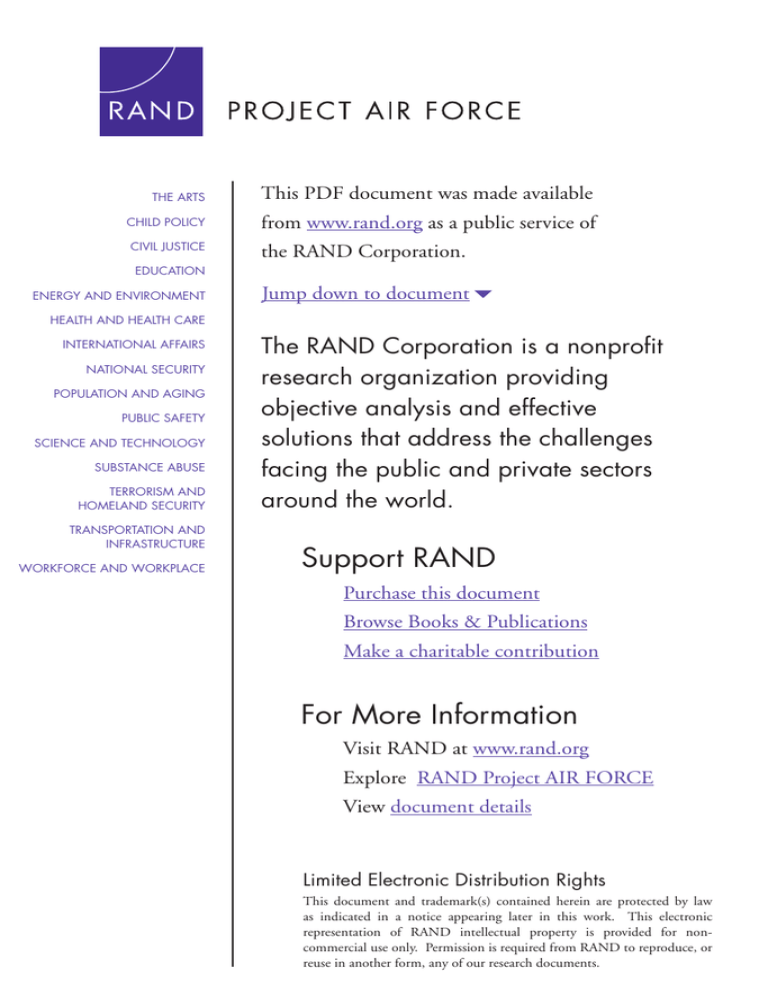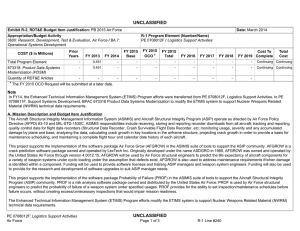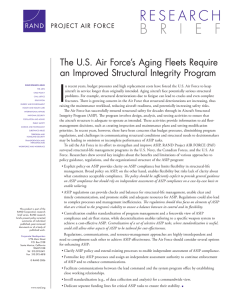
THE ARTS
This PDF document was made available
CHILD POLICY
from www.rand.org as a public service of
CIVIL JUSTICE
the RAND Corporation.
EDUCATION
ENERGY AND ENVIRONMENT
Jump down to document6
HEALTH AND HEALTH CARE
INTERNATIONAL AFFAIRS
NATIONAL SECURITY
POPULATION AND AGING
PUBLIC SAFETY
SCIENCE AND TECHNOLOGY
SUBSTANCE ABUSE
TERRORISM AND
HOMELAND SECURITY
TRANSPORTATION AND
INFRASTRUCTURE
WORKFORCE AND WORKPLACE
The RAND Corporation is a nonprofit
research organization providing
objective analysis and effective
solutions that address the challenges
facing the public and private sectors
around the world.
Support RAND
Purchase this document
Browse Books & Publications
Make a charitable contribution
For More Information
Visit RAND at www.rand.org
Explore RAND Project AIR FORCE
View document details
Limited Electronic Distribution Rights
This document and trademark(s) contained herein are protected by law
as indicated in a notice appearing later in this work. This electronic
representation of RAND intellectual property is provided for noncommercial use only. Permission is required from RAND to reproduce, or
reuse in another form, any of our research documents.
This product is part of the RAND Corporation monograph series.
RAND monographs present major research findings that address the
challenges facing the public and private sectors. All RAND monographs undergo rigorous peer review to ensure high standards for
research quality and objectivity.
A Survey of
Aircraft Structural-Life
Management Programs
in the U.S. Navy, the
Canadian Forces, and
the U.S. Air Force
Yool Kim, Stephen Sheehy, Darryl Lenhardt
Prepared for the United States Air Force
Approved for public release; distribution unlimited
PROJECT AIR FORCE
The research described in this report was sponsored by the United States
Air Force under Contract F49642-01-C-0003. Further information may
be obtained from the Strategic Planning Division, Directorate of Plans,
Hq USAF.
Library of Congress Cataloging-in-Publication Data
Kim, Yool.
A survey of aircraft structural life management programs in the U.S. Navy,
the Canadian forces, and the U.S. Air Force / Yool Kim, Stephen Sheehy,
Darryl Lenhardt.
p. cm.
Includes bibliographical references.
“MG-370.”
ISBN 0-8330-3862-1 (pbk. : alk. paper)
1. Airplanes, Military—United States—Maintenance and repair—Management.
2. Airplanes, Military—Canada—Maintenance and repair—Management.
I. Sheehy, Stephen. II. Lenhardt, Darryl. III. Title.
UG1243.K493 2006
623.74'60288—dc22
2005028956
The RAND Corporation is a nonprofit research organization providing
objective analysis and effective solutions that address the challenges
facing the public and private sectors around the world. R AND’s
publications do not necessarily reflect the opinions of its research clients
and sponsors.
R® is a registered trademark.
© Copyright 2006 RAND Corporation
All rights reserved. No part of this book may be reproduced in any
form by any electronic or mechanical means (including photocopying,
recording, or information storage and retrieval) without permission in
writing from RAND.
Published 2006 by the RAND Corporation
1776 Main Street, P.O. Box 2138, Santa Monica, CA 90407-2138
1200 South Hayes Street, Arlington, VA 22202-5050
4570 Fifth Avenue, Suite 600, Pittsburgh, PA 15213
RAND URL: http://www.rand.org/
To order RAND documents or to obtain additional information, contact
Distribution Services: Telephone: (310) 451-7002;
Fax: (310) 451-6915; Email: order@rand.org
Summary
The U.S. Air Force owns and operates approximately 6,000 aircraft
to meet its force requirements. The average age of these aircraft is
approximately 22 years and is expected to continue to rise. Many of
the older aircraft are facing aging issues, such as structural deterioration due to fatigue, and many aircraft are expected to encounter such
issues as the Air Force plans to keep aging aircraft in service for many
years.
Fatigue is a process in which damage accumulates in material
subjected to alternating or cyclic loading. This damage may culminate in cracks, which will eventually lead to complete fracture after a
sufficient number of load cycles. Concern is growing in the Air Force
that structural deterioration in aging aircraft is increasing the maintenance workload, reducing aircraft readiness, and potentially increasing safety risks (Pyles, 2003).
Since 1958, the Air Force has relied on its Aircraft Structural
Integrity Program (ASIP) to achieve and maintain the structural
safety of its aircraft. ASIP provides a framework for establishing and
sustaining structural integrity throughout the aircraft’s life.1 The program’s overarching objective is to prevent structural failures and to do
so cost-effectively and without losing mission capability. ASIP is a key
contributor to the Air Force’s force management processes, and the
____________
1 Note that the term ASIP applies both to the overall program of the service (and of the
Canadian Forces) and to individual programs tailored for particular aircraft types. Each individual program would include the aircraft designator in its name (e.g., the C-130 ASIP).
xiii
xiv
A Survey of Aircraft Structural-Life Management Programs
program’s ongoing viability will be critical as the Air Force continues
to operate an aging force to meet operational needs.
In recent years, some issues have been raised about inadequate
implementation of ASIP. The concern is that an aging force, budget
pressures, diminishing program regulation, and challenges in communicating structural condition and structural needs to decisionmakers may be leading to omission or incomplete performance of ASIP
tasks. (See pp. 4–6.)
A further concern is that these factors may result in loss of control of ASIP, lack of visibility into the structural conditions of aircraft, and resource-allocation challenges for ASIP. The effectiveness
of ASIP could be degraded, which would adversely affect operational
effectiveness, flight safety, and fleet sustainment costs.
This report surveys aircraft structural-life management programs
in the U.S. Navy, the Canadian Forces, and the U.S. Air Force to
offer insights into how the Air Force could strengthen ASIP, particularly in enabling (1) independent and balanced regulation, (2) clear
and timely communications, and (3) adequate and stable resources to
achieve ASIP effectiveness. Table S.1 compares the technical and
operational backgrounds for each service, and Table S.2 summarizes
the key characteristics of each program.
The U.S. Navy’s Aircraft Structural-Life Management
The Navy operates approximately 2,000 aircraft, based both on carriers and on land. In part because of the limited space and facilities on
carriers for inspection and repairs, the Navy takes a “safe life”
approach to structural-life management. Under this approach, airframes are assumed to be “flawless” at the time of manufacture, and
aircraft are retired by the time fatigue cracks in the airframe initiate,
which the Navy defines as reaching a length of 0.01 inch.
The Navy has an explicit policy on structural-life management.
It establishes strict structural-life limits for each aircraft type and, to
ensure structural safety, requires that aircraft not exceed these limits.
Summary
xv
Table S.1
Comparison of Technical Basis and Operational Factors
U.S. Navy
Force structure
Operational
environment
Technical basis
About 2,000 fixedwing aircraft of 20
types
Carrier- and landbased
Safe life
Canadian Forces
U.S. Air Force
About 350 fixedwing aircraft of 12
types
Land-based
About 6,000 fixedwing aircraft of 40
types
Land-based
Mix of safe life,
damage tolerance
Damage tolerance
These limits are established based on the fatigue-life limit of the airframe and its critical components.
To ensure that the aircraft do not exceed their fatigue-life limits
during service, the Navy tracks individual aircraft fatigue life in terms
of a standard quantifiable metric, fatigue-life expended (FLE). A centralized program rigorously tracks the FLE for all aircraft and disseminates the information in a formal report to the organizations that
support and operate the aircraft. Rigorous and accurate monitoring of
fatigue life is critical to the Navy because, under the safe-life
approach, there is no routine inspection for cracks to validate the
structural condition. The centralized fatigue-life tracking program
further has a dedicated funding line to provide independence to its
assessments and to ensure that this critical task is carried out.
The Program Manager for Air (PMA) is responsible for the total
life-cycle management of the designated fleet. PMA has the ownership and decision authority for structural-life management of the fleet
(except for fatigue-life tracking). PMA uses the FLE information in
making resource allocation decisions, such as conducting a service-life
extension program, force structure planning, and scheduling modifications. The Naval Air System Command’s Structures Division has
regulatory responsibility for the technical aspects of structural-life
management, providing an independent technical assessment of
PMA’s structural-life management decisions. The communications
between the principal organizations involved in structural-life management are primarily informal, facilitated by their working relationship and colocation.
xvi
A Survey of Aircraft Structural-Life Management Programs
Table S.2
Summary of Key Characteristics in the U.S. Navy, the Canadian Forces, and
the U.S. Air Force’s Aircraft Structural-Life Management Programs
U.S. Navy
Canadian Forces
U.S. Air Force
• Structural-life management policies are explicit.
• Authority for the technical aspects of structural-life management is centralized.
• A single, standard metric, FLE, conveys structural conditions.
• Results of rigorous fatigue-life tracking are disseminated frequently, through a formal fatigue-life report.
• Close working relationships and colocation promote and facilitate informal communication.
• The structural-life monitoring program has dedicated funding.
• The policy is broad and is based on the concept of airworthiness.
• The regulatory structure is independent but organizationally
centralized.
• Regulations exist to ensure communication and sharing of
critical information.
• Colocation and close working relationships facilitate informal
communication.
• A single authority (the weapon system manager [WSM]) controls funding for structural-life management for the designated fleet.
• The ASIP master plan provides formal planning for resource
management.
• Policies are broad and flexible and are based on broad
objectives.
• The regulatory structure is flexible and decentralized, with
minimal regulation and oversight.
• Visibility of ASIPs and structural conditions across a command
is limited.
• Communications with the lead command on ASIP and structural issues are limited.
• A single authority (the lead command) controls funding for
structural-life management of the multiple fleets in the command.
The Canadian Forces’ Aircraft Structural-Life
Management
The Canadian Forces operate approximately 350 land-based aircraft
of 12 different aircraft types. Because they are based on U.S. Navy
designs, the Canadian Forces had originally implemented a safe-life
approach to structural-life management. As the Canadian Forces have
Summary
xvii
sought to extend the service lives of their aircraft, however, they have
shifted to a “damage tolerance” approach. Damage tolerance assumes
that the material of the airframe has flaws at the time of manufacture
and that slowly growing cracks in the structure can be tolerated until
they are detected and repaired. Structural inspection intervals are
determined to ensure that a crack does not reach its critical size without being detected. Unlike the U.S. Navy, the Canadian Forces do
not have carrier-based aircraft; thus, implementing a routine inspection for cracks to accommodate the damage-tolerance approach was
not restricted by the space limitations on carriers.
The Canadian Forces take a regulatory approach to structurallife management. An independent regulatory authority, the Technical
Airworthiness Authority (TAA), provides regulations and oversight
for all weapon systems’ ASIPs and assesses compliance. The governing policy regarding structural integrity is broad and is based on the
concept of “airworthiness,” in which the airworthiness requirements
are defined in each aircraft type’s basis of certification. An aircraft
must remain in compliance with its basis of certification throughout
its service life to be considered “airworthy.”
The broad regulations allow each WSM to customize an ASIP
for the specific weapon system. The TAA evaluates ASIP compliance
on a case-by-case basis via formal airworthiness monitoring and
approval processes. The approval processes focus on the tasks that are
the linchpins of aircraft structural-life management, such as the airworthiness certification and design-change certification processes, to
balance the level of regulation.
The regulatory approach requires considerable formal communication. The formal processes require documentation of critical
information for traceability and planning purposes, as well as for
assessing compliance. Additionally, colocation of key authorities in
structural-life management facilitates informal communication
among them.
The resource management plan is formally documented in the
weapon system’s ASIP master plan. As the funding and decision
authority for the fleet’s ASIP, the WSM must approve the plan. The
master plan includes the short- and long-term tasks necessary for
xviii
A Survey of Aircraft Structural-Life Management Programs
maintaining the structural integrity for the fleet. TAA’s regulatory
role provides independent assessments of WSM’s resource allocation
decisions.
The U.S. Air Force Aircraft Structural-Life Management
The U.S. Air Force operates a much-larger force with a wider range of
aircraft types, about 40. The Air Force’s ASIP is based on the
damage-tolerance philosophy described earlier. The governing policy
on ASIP is broad, focusing on the program’s objectives, to allow tailoring of an ASIP for each aircraft type. Each system program director
(SPD) is responsible for implementing an ASIP for its fleet. The lead
command has the funding authority for the fleet management of the
multiple fleets within the command, including ASIPs. As a result, the
lead command has a significant influence on ASIP implementation.2
The Air Force has a flexible, decentralized regulatory structure
with minimal ASIP regulation and oversight. There is no regulation
to enforce certain ASIP tasks or to provide an independent technical
assessment of the lead command’s decisions about structural integrity.
Because of this broad policy, the U.S. Air Force recommends multiple measures for assessing ASIP compliance, including mishap rates
due to structural failure. This measure, however, is problematic
because it is a lagging indicator.
The Air Force does not have a standard metric for communicating aircraft structural condition, partly because of the decentralized
ASIP implementation. As a result, the lead command has a limited
commandwide view of the structural condition of its fleets, and this
makes understanding the relative states of the fleets for resourceallocation purposes challenging.
Communication between the SPD and the lead command about
ASIP and structural condition is limited because of the limited
involvement of the lead command in the ASIP process (other than
____________
2
When more than one major command possesses the same type of weapon system, one of
them will be designated as the lead command for that system.
Summary
xix
budget programming) and the geographic separation between them.
Some lead commands use a technical liaison to facilitate the
communication with the SPDs and to better understand the
implications of the resource decisions (e.g., risk of structural failure,
effects on operational effectiveness, preventing costly repairs).
Observations About Different Approaches
Explicit policy on ASIP provides clarity on ASIP compliance but
limits flexibility in structural-life management. Broad policy on ASIP,
on the other hand, enables flexibility in ASIP implementation for
tailoring but risks lack of clarity about what constitutes acceptable
ASIP compliance. The policy should be sufficiently explicit to provide general guidance on ASIP compliance but should rely on independent assessment of ASIP compliance on a case-by-case basis to
enable tailoring. (See pp. 67–68.)
ASIP regulations can provide checks and balances for structurallife management, enable clear and timely communication, and promote stable and adequate resources for ASIP. Regulations could also
lead to complex processes and management inefficiencies. The regulations should thus focus on elements of ASIP that are critical to the
program’s viability to ensure a balance between its control and flexibility. (See pp. 68–69, 72–75.)
Centralization enables standardization of program management
and a forcewide view of ASIP compliance and aircraft fleet status,
while decentralization enables tailoring to a specific weapon system to
achieve a cost-effective ASIP. Centralization of a set of selective ASIP
tasks, where standardization is useful, could still allow other aspects of
ASIP to be tailored for cost-effectiveness. (See p. 71.)
Regulations, communications, and resource-management approaches are highly interdependent and need to complement each
other and the context of the program (e.g., safe-life versus damage
tolerance) to achieve ASIP effectiveness. Operational factors, such as
the force size, may present certain scalability challenges. The U.S. Air
Force’s large-scale force with its wide range of aircraft types may pose
xx
A Survey of Aircraft Structural-Life Management Programs
some challenges for standardizing and/or centralizing certain aspects
of ASIP across the force.
Options for the Future
Our survey suggested several options for the Air Force to consider for
enhancing ASIP:
• Clarify ASIP policy and extend existing processes to enable
independent assessment of ASIP compliance.
• Formalize key ASIP processes and assign an independent assessment authority to continue enforcement of ASIP and enhance
communications.
• Facilitate communications between the lead command and the
system program office by establishing close working relationships.
• Instill standardization for commandwide view.
• Dedicate separate funding lines for critical ASIP tasks.






